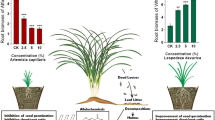Abstract
On many hillsides of Taiwan there is a unique pattern of weed exclusion byPhyllostachys edulis (bamboo) andCryptomeria japonica (conifer) in which the density, diversity, and dominance of understory species are very different. Although the physical conditions of light, soil moisture, and soil nutrients strongly favor the growth of understory in a bamboo community, the biomass of its undergrowth is significantly low, indicating that physical competition among the understory species in the bamboo and conifer communities does not cause the observed differences. However, the biochemical inhibition revealed by these two plants appeared to be an important factor. The growth ofPellionia scabra seedlings, transplanted from the study site into greenhouse pots, was evidently suppressed by the aqueous leachate of bamboo leaves but was stimulated by that of conifer leaves. The radicle growth of lettuce, rye grass, and rice plants was also clearly inhibited by the leachate and aqueous extracts of bamboo leaves but not by those of conifer leaves. Six phytotoxins,o-hydroxyphenylacetic,p-hydroxybenzoic,p-coumaric, vanillic, ferulic, and syringic acids were found in the aqueous leachate and extracts of leaves and alcoholic soil extracts ofP. edulis, while the first three compounds were absent in the extracts ofC. japonica. The phytotoxicities of extracts were correlated with the phytotoxins present in both leaves and soils. The understory species might be variously tolerant to the allelopathic compounds produced by the two plants, resulting in a differential selection of species underneath. Therefore, comparative allelopathic effects ofPhyllostachys edulis andCryptomeria japonica may play significant roles in regulating the populations of the understories.
Similar content being viewed by others
References
Anaya, A.L., andDel Amo, S. 1978. Allelopathic potential ofAmbrosia cumanensis H. B. K. (Compositae) in a tropical zone of Mexico.J. Chem. Ecol. 4:289–304.
Borner, H. 1971. German research on allelopathy, pp. 52–57,in Biochemical Interactions Among Plants. National Academy of Sciences, Washington, D.C.
Chou, C.H. 1980. Allelopathic researches in the subtropical vegetation in Taiwan.Comp. Physiol. Ecol. 5:222–234.
Chou, C.H., andChiou, S.J. 1979. Autointoxication mechanism ofOryza saliva II. Effects of culture treatments on the chemical nature of paddy soil and on rice productivity.J. Chem. Ecol. 5:839–859.
Chou, C.H., andChung, Y.T. 1974. Allelopathic potential ofMiscanthus floridulus.Bot. Bull Acad. Sin. 15:14–27.
Chou, C.H., andHou, M.H. 1981. Allelopathic researches of subtropical vegetations in Taiwan I. Evaluation of allelopathic potential of bamboo vegetation.Proc. Natl. Sci. Counc. B. ROC 5:284–292.
Chou, C.H., andLin, H.J. 1976. Autointoxication mechanism ofOryza sativa I. Phytotoxic effects of decomposing rice residues in soil.J. Chem. Ecol. 2:353–367.
Chou, C.H., andYoung, C.C. 1974. Effects of osmotic concentration and pH on plant growth.Taiwania 19:157–165.
Chou, C.H., andYoung, C.C. 1975. Phytotoxic substances in twelve subtropical grasses.J. Chem. Ecol. 1:183–193.
Cottam, G., andCurtis, G.T. 1949. A method for making rapid surveys of woodlands by means of pairs of randomly selected trees.Ecology 30:101–104.
Del Moral, R., andCates, R. G. 1971. Allelopathic potential of the dominant vegetation of western Washington.Ecology 52:1030–1037.
Friedman, J., Orshan, G., andZiger-Cfir, Y. 1977. Suppression of annuals byArtemisia herba-alba in the Negev desert of Israel.J. Ecol. 65:413–426.
Gleissman, S.R., andMuller, C.H. 1978. The alleopathic mechanisms of dominance in bracken (Pteridium aquilinum) in southern California.J. Chem. Ecol. 4:337–362.
Grodzinsky, A.M. 1971. Problems and results of allelopathy in the work of Soviet scientists, pp. 44–51,in Biochemical Interactions Among Plants. National Academy of Sciences, Washington, D.C.
Jameson, D.A. 1970. Degradation and accumulation of inhibitory substances fromJuniperus osteosperma (Torr.) Little.Plant Soil 33:213–224.
Koeppe, D.E., Southwick, L.M., andBittell, J.E. 1976. The relationship of tissue chlorogenic acid concentrations and leaching of phenolics from sunflowers grown under varying phosphate nutrient conditions.Can. J. Bot. 54:593–599.
Kuo, P.C. 1958. Cover plants underneathCryptomeria stands in Shitou.Exp. For. Natl. Taiwan Univ. For. Ser. 18:1–6.
Lee, I.K., andMonsi, M. 1963. Ecological studies onPinus densiflora forest I. Effects of plant substances on the floristic composition of the undergrowth.Bot. Mag. 76:410–413.
Mabry, T.J., Markham, K.R., andThomas, M.B. 1970. The Systematic Identification of Flavonoids. Springer-Verlag, New York, 354 pp.
Muller, C.H. 1966. The role of chemical inhibition (allelopathy) in vegetational composition.Bull. Torrey Bot. Club 93:332–351.
Muller, C.H. 1969. Allelopathy as a factor in ecological process.Vegetatio 18:348–357.
Muller, C.H. 1974. Allelopathy in the environmental complex, pp. 37–85,in B.R. Strain, and W.D. Billings, (eds.). Handbook of Vegetation Science. Part VI. Vegetation and Environment. Dr. W. Junk B.V. Publisher, The Hague.
Neuman, E.I., andMiller, M.H. 1977. Allelopathy among some British grassland species II. Influence of root exudates on phosphorus uptake.J. Ecol. 65:399–401.
Peterson, E.B. 1972. Determination of the presence, location, and allelopathic effects of substances produced byJuniperus scopulorum Sarg.Diss. Abstr. B. 32:3811–3812.
Rice, E.L. 1974a. Allelopathy. Academic Press, New York, 353 pp.
Rice, E.L. 1974b. Laboratory Manual for Physiological Plant Ecology. University of Oklahoma. MS.
Rice, E.L. 1979. Allelopathy—an update.Bot. Rev. 45:17–109.
Vásquex, A., Méndez, J., Gesto, M.D.V., Seoane, E., andVieitez, E. 1968. Growth substances isolated from woody cuttings ofSalix viminalis L. andFicus carica L.Phytochemistry 7:161–167.
Wang, T.S.C., Cheng, S.Y., andTung, H. 1967. Dynamics of soil organic acids.Soil Sci. 104:138–144.
Author information
Authors and Affiliations
Additional information
Paper No. 253 of the Scientific Journal Series of the Institute of Botany, Academia Sinica, Taipei, Taiwan. This study was supported by the National Science Council of the Republic of China.
Rights and permissions
About this article
Cite this article
Chou, CH., Yang, CM. Allelopathic research of subtropical vegetation in Taiwan II. Comparative exclusion of understory byPhyllostachys edulis andCryptomeria japonica . J Chem Ecol 8, 1489–1507 (1982). https://doi.org/10.1007/BF00989105
Received:
Revised:
Issue Date:
DOI: https://doi.org/10.1007/BF00989105




